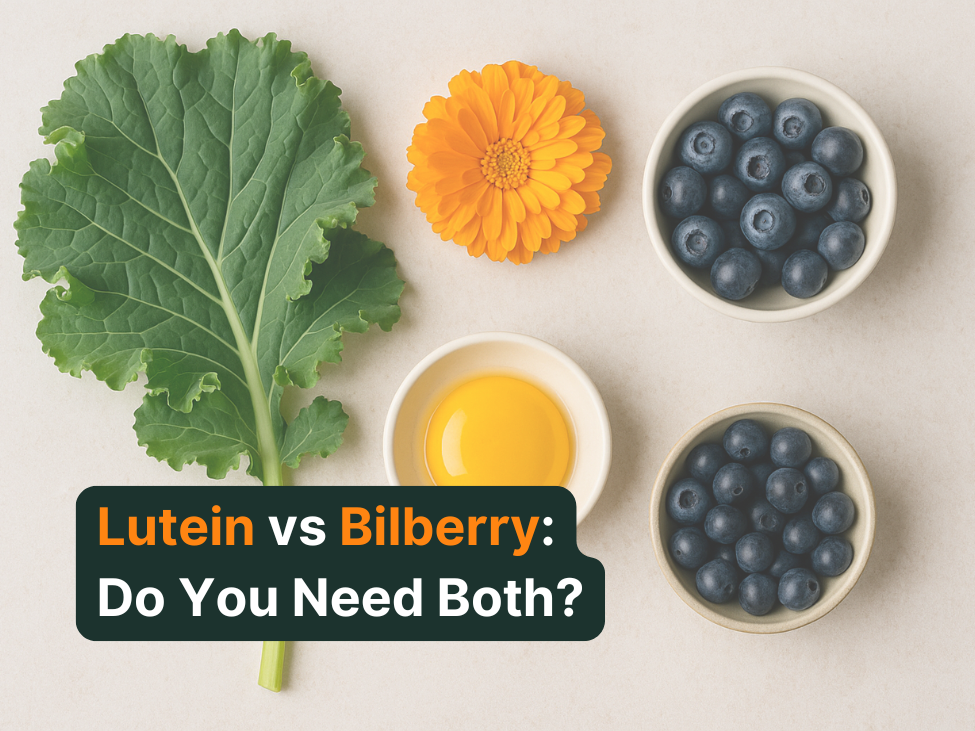Lutein vs Bilberry for Eyes: What’s the Difference And Do You Need Both?
 Brian Ang
Brian Ang

If you’ve been exploring ways to support your eyes, especially in the age of digital screens, strain, and artificial light, you’ve likely come across lutein and bilberry.
Both are natural compounds with proven benefits for vision. Both show up in high-quality eye supplements. And both have been used for decades. But they work differently. And together, they tell a more complete story about supporting your eyesight — and your overall health — long term.
Here’s what makes each one unique.
Lutein: Your Eyes’ Natural Filter

Lutein has been known to science since the 1800s; a golden pigment found in marigold flowers, kale, and egg yolks. But its role in vision only came into focus more recently, when researchers discovered that lutein concentrates in the macula, the part of the eye responsible for sharp central vision.
There, it acts like a natural pair of sunglasses, absorbing harmful blue light and shielding the retina from oxidative damage caused by radiation.
Later studies showed that lutein also accumulates in the brain, especially in regions involved in visual processing and memory. In older adults, higher lutein levels are linked to faster reaction times and better cognitive performance — making it one of the few nutrients that supports both sight and cognition (others include ginkgo biloba and methylcobalamin).
Lutein helps with:
- Supporting macular function
- Filtering digital blue light and UV radiation
- Reducing glare and visual fatigue
- Supporting contrast sensitivity and visual acuity
- Cognitive clarity and brain health
Bilberry: The WWII Pilot’s Secret Weapon

During World War II, British fighter pilots were said to eat bilberry pie before flying night missions. Whether myth or military strategy, their belief was simple: bilberries helped them see better in the dark.
We now know there’s science behind the story. Bilberries are rich in anthocyanins, antioxidant compounds that improve blood flow to the retina and strengthen fragile capillaries. But even more importantly, anthocyanins help regenerate rhodopsin — a pigment inside the eye’s rod cells, which are responsible for low-light and night vision.
That’s why bilberry isn’t just good for tired eyes; it may also help with:
- Adapting to darkness or low lighting
- Night driving and scotopic vision
- Faster recovery after glare or flash exposure
- Dry eye relief
- General retinal function as we age
And because anthocyanins support circulation system-wide, bilberry also contributes to vascular health and optic nerve function.
How Lutein & Bilberry Compare
| Lutein | Bilberry | |
|---|---|---|
| Nutrient type | Carotenoid | Anthocyanin (flavonoid) |
| Primary role | Filters blue light, supports macula health | Promotes circulation, supports retina function and tear production |
| Best for | Visual acuity, glare, screen fatigue | Dry eyes, eye strain, night vision |
| Bonus benefits | Brain health, cognitive processing | Vascular support, antioxidant defense |
Should You Take Both?
In most cases, yes — they do different jobs.
Lutein supports your central vision and macula, and helps your brain process visual input clearly.
Bilberry supports blood flow, retina function, and comfort — especially if your eyes feel dry or tired by mid-afternoon.
That’s why many advanced vision supplements, like Nutravision, combine both. Together, they offer wider coverage: structure and function, clarity and comfort.
What to Look For in a Supplement
Lutein (and Zeaxanthin)
- Dosage: Aim for 5–10 mg of lutein per day, ideally paired with 1–2 mg of zeaxanthin. This is close to the ratio found naturally in the macula.
- Form: Look for free lutein, not lutein esters. Free lutein is the form your body actually uses — and it’s more readily absorbed, especially when taken with a meal that contains healthy fats (olive oil, avocado, nuts) to boost absorption.
- Bonus: Some advanced formulas also include meso-zeaxanthin, another macular carotenoid found at the very centre of the retina. While not common in food, it’s present in the macula and may offer enhanced protection against oxidative stress and glare sensitivity — particularly in those who need extra macula support.
- Good to know: Nutravision uses Lutemax 2020, which features free lutein as well as zeaxanthin and mesozeaxanthin isomers.
Bilberry Extract
- Active compound: Anthocyanins are the active antioxidant compounds responsible for its effects on circulation, inflammation, and retinal function. Be cautious of vague labels like “bilberry powder” or “wild berry complex,” which often contain little active compound.
- Standardisation: Many supplements use bilberry standardised to 25% anthocyanins, but clinical benefit is more consistent with extracts at 36%. Look for a bilberry extract standardised to 36% anthocyanins.
- Good to know: Nutravision uses wild-harvested European bilberries standardised to 36% anthocyanins, the gold standard used in clinical trials.
Final Thoughts on Lutein vs Bilberry
From fighter pilots to modern-day screen workers, lutein and bilberry have earned their place in serious eye support. They aren’t hype ingredients; they’re smart, science-backed nutrients that support how you see and how you feel.
Whether you're managing dryness, mental fatigue, or simply planning ahead for long-term vision, this combination is worth keeping in focus. Together, they support the kind of vision you don’t notice when it’s working well — but would miss if it wasn’t.



